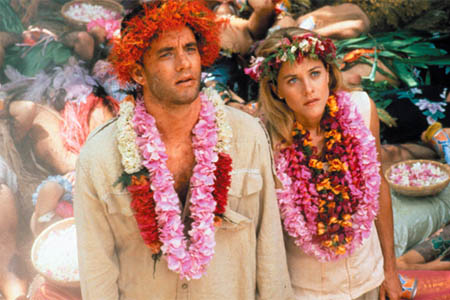“It is not an entirely successful movie,” Roger Ebert wrote back in 1990 when Joe Versus the Volcano premiered, “but it is new and fresh and not shy of taking chances. And the dialogue in it is actually worth listening to, because it is written with wit and romance.”
Alas Roger was one of the few susceptible to the wit and romance of John Patrick Shanley’s film maudit, a deliciously spectacular piece of cinematic insanity of the sort that Hollywood used to allow in the wake of a major success. The success in this case was Moonstruck, a romantic comedy bonanza that won Shanley the Oscar for Best Original Screenplay in 1987 along with the Best Actress prize for Cher and Best Supporting Actress for Olympia Dukakis. Now given the full moviemaking reins with apparently no one to “rein him in,” Shanley set about creating a cross between Frank Capra’s “forgotten man” saga Meet John Doe and King Vidor’s south sea volcanic insanity Bird of Paradise. It tells of a “John Doe” named Joe (Tom Hanks) stuck in a hellish dead-end job (a rectal probe manufacturing company) who learns from an eccentric millionaire named Graynamore (Lloyd Bridges) that he has only a few months to live thanks to a condition called a “brain cloud.” That being the case Joe is invited by Graynamore to take an all-expenses-paid cruise to a remote Pacific Island and jump into its highly active volcano, thus “appeasing the Gods” and allowing Graynamore the opportunity to gain further millions from the rare mineral found on that island, pivotal to the manufacture of “superconductors.”
If this premise sounds off-the-wall-wacky to you, then you’ll doubtless find wackier still the fact that executive producer Steven Spielberg gave Shanley untold millions for the elaborate sets (by Bo Welch of Beetlejuice fame) and special effects (from the wizards of George Lucas’s Industrial Light and Magic) required to realize it, resulting in a work every bit as attractive to moviegoers as One from the Heart and 1941—which is to say not at all. Just like those cursed Coppola and Spielberg megaflops Joe Versus the Volcano is cinematically exciting to those undemanding of realism or logic in their movie going. In other words its’ “For the Happy Few.”
‘The entire movie,’ writes Roger Ebert, ‘allows fantasy back into the movies again. Like ‘Metropolis,’ ‘The Wizard of Oz,’ ‘Ghostbusters,’ or ‘Batman,’ this movie isn’t content to photograph the existing world—it goes to the trouble of creating its own.’
“Joe Versus the Volcano achieves a kind of magnificent goofiness,” Roger rightfully declares. “Hanks and Ryan are the right actors to inhabit it, because you can never catch them going for a gag that isn’t there: They inhabit the logic of this bizarre world and play by its rules.” And the most striking of these rules allows for Ryan to play not one role but three: Joe’s beleaguered office co-worker DeeDee, and Graynamore’s two daughters—the ditzy Anjelica and the true-blue Patricia, who becomes a “love interest” so committed that she joins our hero in jumping into that volcano.
It’s really not much of a “spoiler” to point out that they survive. This isn’t a “black comedy” in any way, shape, or form. Moreover Shanley’s interest is less in standard narrative than in details—like the four enormous waterproof steamer trunks our hero buys for his trip that become a deus ex machina when the ship he’s traveling in sinks, and likewise the island in the wake of his attempt to staunch an eruption through human sacrifice. And did I mention that the island’s inhabitant, the “Waponis” have Abe Vigoda as a ruler, Nathan Lane as their High Priest, drink nothing but Orange soda, sing native folk songs” derive from “Hava Nagila” and “When Johnny Comes Marching Home?”
You’re welcome.
“The entire movie,” writes Roger, “allows fantasy back into the movies again. Like Metropolis, The Wizard of Oz, Ghostbusters or Batman this movie isn’t content to photograph the existing world—it goes to the trouble of creating its own. True, and in that sense I’d liken it to Modesty Blaise, Tales of Hoffman and Under the Cherry Moon as well. Shanley began his career as a playwright of romantic fantasy (Danny and the Deep Blue Sea) that he honed to a slightly more serious level with Moonstruck and then went all out with Joe.
Undeterred by this fiasco Tom Hanks and Meg Ryan went on to team up again with overwhelming success in Sleepless in Seattle (1993) and You’ve Got Mail (1998). Shanley meanwhile retreated to screenwriting (Congo, Alive), not directing a film again until 2008 with Doubt,his very serious adaptation of his very serious play about the Catholic Church and the handling of a suspected child molestation scandal. It was absolutely wonderful thanks to Shanley’s clear-eyed writing and the superb performances of Meryl Streep, Phillip Seymour Hoffman, Amy Adams and Viola Davis. It charts a new and very assured course for him. Nevertheless I can’t help but hope that Shanley still has a Volcano in him waiting to let loose some day.




